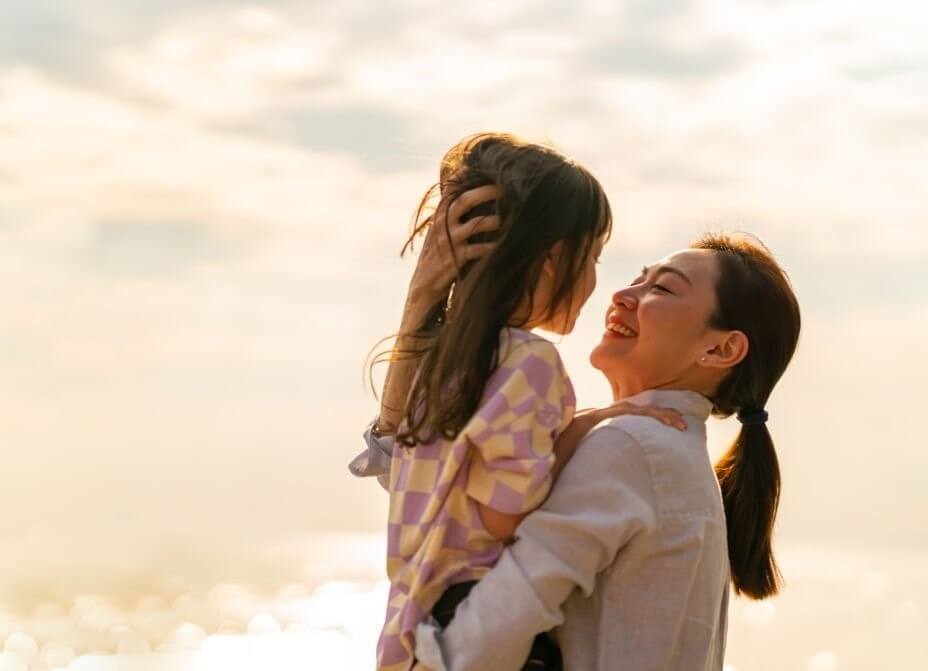The journey of parenting is like weathering an unpredictable chaotic storm. At times, you may face unexpected challenges that threaten to knock you off the balance. Other times, you are in the eye of the storm, savouring every moment of hard-earned calmness, while staying hyper-vigilant for the next returning storm.
Parents may find themselves in such situations learning to navigate their ways. It can feel exhausting, frustrating and overwhelming. Storms do pass. This is the hope we want to offer in this blog article – Parents can emerge from it, feeling wiser, calmer and encouraged.
In “The Power of Showing up”, the scientific research work of Dr Dan Siegel and Dr. Tina Payne Bryson has shown that “One of the very best predictors for how a child turns out—in terms of happiness, social and emotional development, leadership skills, meaningful relationships, and even academic and career success—is whether they developed security from having at least one person who showed up for them.” Children need parents — at least one of them — to show up, consistently helping them to feel safe, seen, soothed, and secure.
As a parent of two pre-schoolers, I like to share some handles attempted in “showing up” to calm their brains. If you have young children between 7-12 years old, may this article value-add to your existing parenting skills.
The Impact of Stress to the Child
We are aware that stress can be a major challenge for children. We will look at the psychological and physiological effects of stress on children’s growing brains and bodies.

Have we ever wondered what happens in a child’s brain when he gets scared in the middle of a thunderstorm? The amygdala, the emotional part of our brain that keeps us safe is activated when the bodies sense danger. It acts like a fire alarm that causes bodily responses like fight, flight or freeze to protect us from the storm.
Stress is inevitable at different developmental stages where children are presented with new tasks to learn and grow. Under normal circumstances, our mental, emotional, and physical states should return to normalcy once the stressful event is over. Small amounts of brief stress can be healthy and promotes growth.
Stress becomes unhealthy to the body when a child is always overwhelmed with the prolonged feeling of helplessness, powerlessness and hopelessness. They have difficulty seeing that situation can change or improve when it felt like one’s control, stability and safety in functioning had been constantly taken away.
Why can’t my child be as calm as an adult?

The pre-frontal cortex, also known as the thinking brain, is an important difference between a child’s and an adult’s brain. From research studies, this thinking brain is developing throughout a child’s growing up year and fully matures by 25 years old. An adult will be able to use their pre-frontal cortex to assess the extent of a threat, calm fear down, evaluate and problem-solve. Basically, children do not have the full capacity of the pre-frontal cortex yet to self-regulate and do these things.
When children are hit by chronic stress, the brain capacity for safe learning and growth is limited. Majority of the time, the brain is occupied at hyper-vigilant mode to keep perceived threats away. It affects the capacity of the prefrontal cortex for regulating thought, emotions, and actions, as well as absorbing information for active learning, in their developing years.
Why is co-regulation from adults important for children?

When children experience stress, it can be challenging for them to express in words what they are experiencing. Instead, these are some the behavioural symptoms that might be the tell tale signs of the big emotions of fear, scared, worry, confused, lost:
- School refusal
- Angry outburst – shouting and yelling
- Bullying
- Lying
- Self-harm
- Restlessness/Difficulty in concentrating/Procrastination
- Talking less
- Stomach-ache/Giddy spells/Frequent Urination
Children need trusted adults around them to acknowledge the emotions and thoughts in the stress and work together with them on problem-solving strategies. This is with the hope of building their ability towards self-regulation of emotions, thoughts and behaviours.
Borrowing the wisdom of Dr Gabor Mate Renowned expert on trauma, addiction, stress and childhood development. “Children don’t get traumatized because they get hurt. They get traumatized because they are alone with the hurt.”
Putting that wisdom in this context:
“Stress does not break children. Stress breaks children when they feel alone and unsupported in the storms.”
How can I calm and engage my child’s big emotions through the “ABCDE” handles?
Acknowledge and Be Curious of the alarm (amygdala):
Acknowledging and validating the stress children experience at that moment can calm their fear system down quickly because it made them feel seen, heard and normalized for their experiences. Parents can stay with the difficult experiences of children with curiosity and compassion. This is to create safe space for every child to develop emotional and mental wellness, where each hard-to-have emotion can be safely named, mirrored and accepted without shame.
- It is natural to feel this emotion (name it out eg. Fearful, scared, worried, confused, lost) when this happened. What the person did to you is definitely not ok.
- It is normal that you find it hard to sleep/concentrate when you feel this way.
- This piece of homework is really difficult and making you feel horrible inside. I know you are creative in problem-solving with new ideas. Let’s figure this challenge out together. We do the homework together.
- I am glad you are trying to let me know these hard-to-have feelings. It is really tough. I am with you. I got you. Let’s look at how we can support you on this.
- This is really important. What had happened really matters. I am here. Let us figure this out together. When you are ready, tell me what happened?
- You are just feeling scared and stupid at the moment. You are not stupid.
- You are having crazy thoughts now. You are not crazy. You feel really worried. With time, we will get through this.
- I believe your feelings and thoughts. I am not blaming you for what you feel. Your feelings need help. I am here to do this with you.
Calm down through co-regulation:
Often, parents have the belief that acknowledging children’s emotions, needs and hopes means giving in to their requests and not correcting their behaviour. Acknowledging with curiosity and compassion is an important process of calming the emotional brain down so that the reasoning part of the brain can be engaged to think, reflect, correct and problem-solve.
Do not dismiss the emotions and needs:
I hold a belief that there is no right or wrong emotion. Every emotion serves a purpose, need and value. When children experience adults being curious and not judging them for their experiences, they learn validation and soothing in the process. They do not feel blamed, judged and shamed for what happened to them. Rather, they know that these emotions, thoughts, needs and desires are normal to have and feel as human beings.
Engage the reasoning brain (pre-frontal cortex):
Questions can be employed with curiosity and clarity to engage the reasoning brain to tap their partial acquired linguistic and reflection skills, so as to build resiliency in problem-solving to bring forth their voice. This is one of the ways to encourage self-awareness and others-awareness.
- What are you most worried about?
- What would the worst scenario look like?
- Do you think other of your friends might be feeling stressed too?
- When you feel stressed, what do you tell yourself?
- Let’s think of different ways we can do to move the stress away.
- Let’s figure out what else we can say to stress, so that stress can step aside and let you do the work.
- Shall we let stress know that you are and will do your best, and you are not alone figuring this out?
While the above “ABCDE of calming and engaging the brain” is written alphabetically for easy understanding of the concepts behind calming and engaging the brain, it is not intended to be used in an ordered manner. Parents can be creative to incorporate the above and integrate into their current parenting styles.
Often, when the emotional brains in both my children and mine were activated, I had learnt (still learning, my life’s ongoing project) to self-regulate internally so as to calm down my activated system, before I could attend to my children’s.
Many of us may not have the privilege of being raised in environments with experiences of co-regulation from our caregivers. We have learned to cope and survive through our emotional storms by dismissing and denying our emotions, needs and desires.
While raising children in our own parenting journey, we are also raising and soothing another child – the younger part of us. This can feel stressful and overwhelming for any parent. Do reach out to us so that we can journey with you in different phases of parenting.

“Stress does not break parents. Stress breaks parents when they feel alone and unsupported in the storms.”
Written by Valerie Oh.




